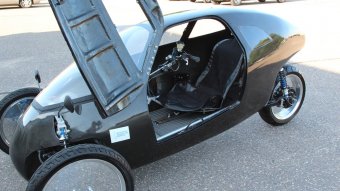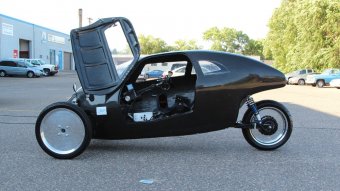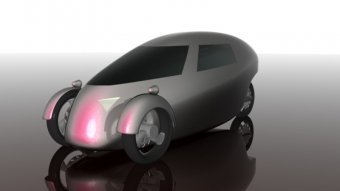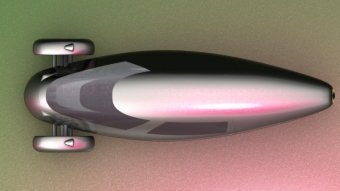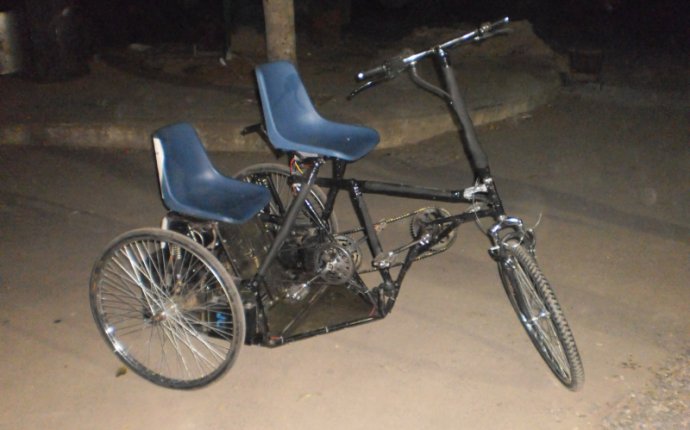
Human Powered Electric Vehicle
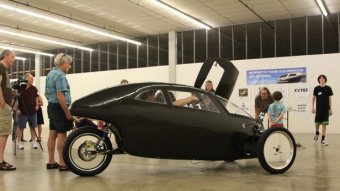 The prototype Raht Racer – Raht standing for Recumbent Human Automobile Transit
The prototype Raht Racer – Raht standing for Recumbent Human Automobile Transit
With their sleek shells providing both protection from the elements and an aerodynamic advantage over bicycles, human-powered velomobiles do offer an intriguing alternative to cars. Unfortunately, though, they can't go as fast as automobiles, meaning that they often still have to be ridden along the side of the road. Minneapolis-based inventor Rich Kronfield wants to change that, with his Raht Racer. It's an electric-assist velomobile that amplifies the rider's pedaling power, reportedly allowing them to move as fast as the cars around them.
Most velomobiles consist of a recumbent tricycle body, enclosed by a full aerodynamic fairing. Some of them also have an electric-assist motor, although the top speed possible with these is usually limited to around 20 mph (32 km/h) – any faster, and they'd have to be registered and insured as motor vehicles.
Some of them also have an electric-assist motor, although the top speed possible with these is usually limited to around 20 mph (32 km/h) – any faster, and they'd have to be registered and insured as motor vehicles.
Kronfield apparently thinks that would OK, though, given that users would still save all the money they'd otherwise be spending on gas.
Instead of directly driving the wheels, the Raht Racer's pedals are connected to a unique flywheel generator that powers the vehicle's 20-kWh electric motor (located in the rear wheel hub). As with regular pedal-assist electric bicycles, this system senses the torque being applied to the pedals by the rider, then uses the motor to amplify it. In the case of the Raht Racer, however, it's supposedly amplified to the point that an average adult should be easily able to maintain a cruising speed of around 30 mph (48 km/h) – or over.
 Some of the pedaling power is also used to charge the 9.2-kWh li-ion battery pack, helping to extend its range. That battery gets its full charge from a wall outlet, between rides. If used in throttle-only mode, in which the rider does no pedaling, it has a range of approximately 50 miles (80 km). Full-out, throttle mode will take the vehicle to a top speed of 100 mph (160 km/h).
Some of the pedaling power is also used to charge the 9.2-kWh li-ion battery pack, helping to extend its range. That battery gets its full charge from a wall outlet, between rides. If used in throttle-only mode, in which the rider does no pedaling, it has a range of approximately 50 miles (80 km). Full-out, throttle mode will take the vehicle to a top speed of 100 mph (160 km/h).
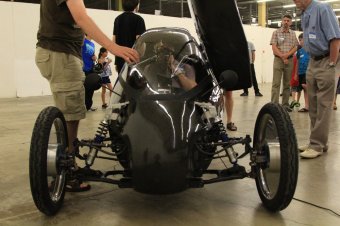 The two-seater Raht Racer itself has a carbon fiber body with an aluminum roll cage, and includes features such as headlights, tail lights, seat belts, air bag, trunk space and full suspension. The current prototype tips the scales at 570 lb (259 kg) so yep, it's a good thing that it's not purely human-powered.
The two-seater Raht Racer itself has a carbon fiber body with an aluminum roll cage, and includes features such as headlights, tail lights, seat belts, air bag, trunk space and full suspension. The current prototype tips the scales at 570 lb (259 kg) so yep, it's a good thing that it's not purely human-powered.
It all sounds pretty intriguing, and it will be interesting to see if the Raht Racer lives up to the hype. If you want one, though, you'd better plan on it saving you a lot of gas – its estimated price is between US$35, 000 and $45, 000. Should you still be interested, Rich and his team are currently raising production funds, on Kickstarter. A pledge of $250 or more will get you on the waiting list.
